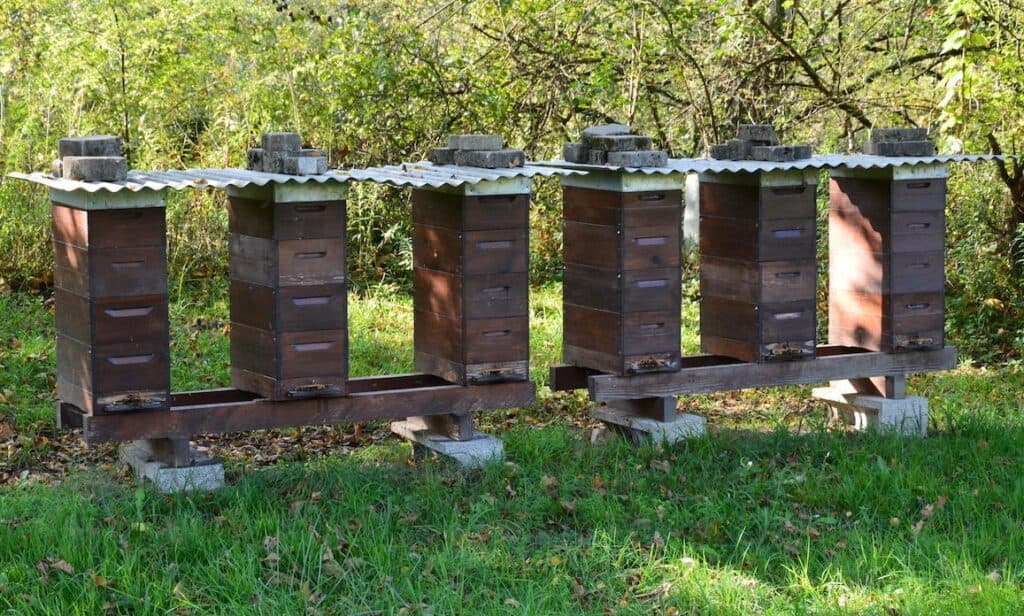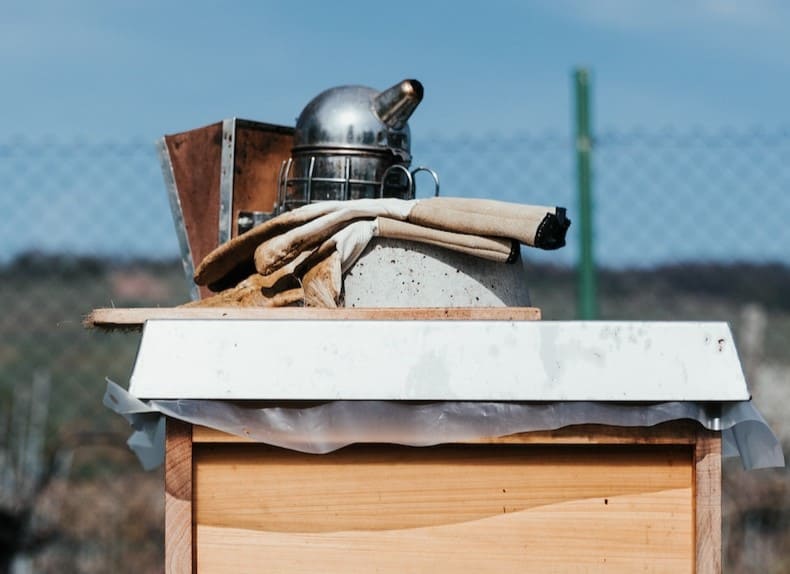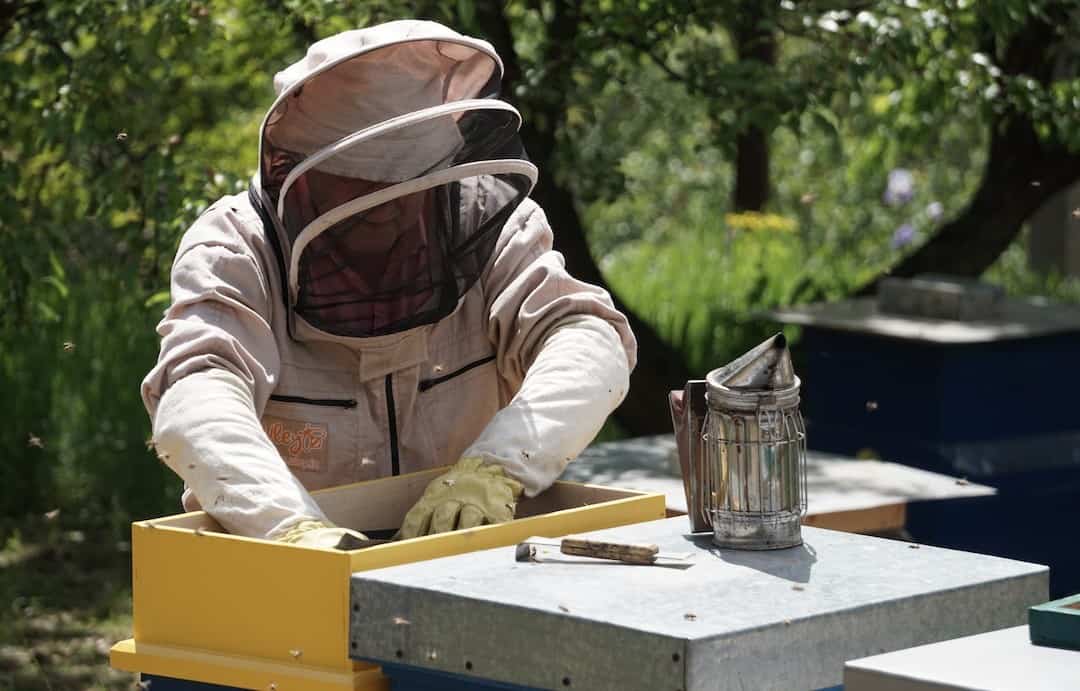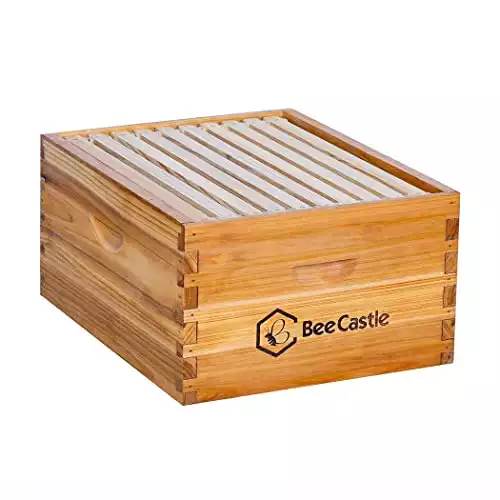You’ve heard the plight of the honey bees. You feel the need to answer that call.
Before you get too emotionally invested in the cause, the little accountant who resides at the back of your brain who doesn’t get a word in when you see some fabulous shoes decides to pause your noble thoughts with the question, “What’s it going to cost to start beekeeping”?
Well, the key to understanding the cost of beekeeping is learning what you truly need to start versus what you want.
Personally, I started out with way more equipment than I should have, and I wouldn’t want you to make the same mistake.
So, what is the real cost of beekeeping for the first year? The short answer is $500- $700. This includes everything you need to get started, such as good information, a beehive, equipment, bees, mite control, and sugar.
Let’s dive deeper and see exactly how these costs break down.

6 Primary Things You Need to Buy to Start Keeping Bees
There are six primary beekeeping costs you must consider. Before starting your journey as a beekeeper, take a close look at each of these costs. You might get an idea or two on how you can save money.
1. Information (Approximately $20)
Buy a book. Cost: Approximately $20 (or less if you have an e-reader)
Many of the mistakes and added costs beekeepers make in their first year are out of ignorance. I started beekeeping without the slightest clue about what I was getting into.
You are spoilt for choice when it comes to good beekeeping books, but there are three that come to mind.
- ‘The Backyard Beekeeper‘ by Kim Flottum, which is in its fourth edition now,
- ‘The Beekeepers Handbook‘ by Diane Sammataro and Alphonse Avitabile
- ‘Beekeeping for Dummies‘ by Howland Blackiston.
These are books you will keep referring to, so it’s a worthwhile investment. With time, depending on how deep your passion is, you will expand your collection.
2. A Beehive (Cost: $150-$200)
A Langstroth hive is usually the easiest place to start beekeeping as a beginning beekeeper. The cost is usually $60-$200, depending on where you purchase it from.
There are many different types of hive options available, but many experienced beekeepers own this type, and therefore, information and equipment are readily available.
The first thing you’ll want to do is to visit the local beekeeper’s association or beekeeping community. This is because you’ll need to know what configuration of bee boxes your colony will need to get through the winter.
This varies depending on what zone you’re in. Areas with long winters will need more resources in terms of brood size and stores to get through the winter.
More temperate areas, such as Hawaii, may have nectar sources for most of the year and can make it through cold spells on much less.
You’ll start off with brood boxes. The number will depend on the typical number needed to overwinter (getting the bees through the winter period of no nectar).
Although you won’t put them all up at the same time, it is good to have them so that when the bees are almost done constructing comb on one, the other is ready to be added.
TIP: You could also start off with Beekeeping Starter Kits that would make you skip #3 below. These kits come with a beehive box(es), plus the tools and accessories you need to start your beekeeping journey.
3. Beekeeper Basic Tools & Accessories (Cost: $100-$300)

Smoker, bee brush, hive tools, and full bee suit. Cost – $100-$300
I suggest you get this beginner kit before your bee package arrives. You’ll need them when you’re showing your new colony their new residence.
The hive tool like this one here is necessary to help you get past the propolis-sealed cover and frames. The bee smoker keeps the bees distracted while you go about your business in the hive.
The bee brush helps you brush away nurse bees when you want to get a good look at the brood.
Finally, the protective clothing keeps you sting-free (for the most part) as you go about activities that involve opening the hive. The price for this would vary depending on whether you would want a bee jacket alone or full protective gear.
As a new beekeeper yourself, I would suggest protective clothing that would cover your whole body parts lest your first encounter with a honey bee would immediately sting you off the world of beekeeping.
4. Bees (Cost $100-$350)

The cost of acquiring bees will range from $100-$350 (but if you catch a wild swarm, it’s free!)
Without them, your hives would just be eccentric pieces of furniture.
Bees can be purchased as packaged bees or as a nucleus colony or nucleus hive (known as a nuc). If you are very lucky, you could catch a swarm.
In spring, once the colony has expanded in number, the colony can raise a new queen.
In that case, the old queen has to leave, and she gets a few loyal subjects as part of her retirement package. Sometimes, they can identify your hive as their new home.
Other times, they settle in a tree nearby. Even then, you can capture the swarm and move them into your hive. That would be a way of saving money as you begin beekeeping.
5. Mite Control (Cost: $20-$200)
Mite treatments will range from $20-$200, depending on the method of treatment.
This is very important in the fight against varroa mites and tracheal mites.
This is one of the greatest challenges that a beekeeper will face. A lot of effort is going into studying these parasites, especially the varroa mites, because they have caused a lot of damage to the bee population in the U.S.
Depending on the hive that you have, you may want to trade in your solid board for a screened board as one of your go-to varroa mite treatments. Underneath the board is a space where a tray with a layer of adhesive is placed.
Screened boards like this one are a safe way to monitor mite levels without the excessive use of chemicals.
Once the mite falls off the bee, it falls past the screen and sticks to the tray below it. This keeps it from climbing back into the hive and infecting the other bees.
This is only one way to manage the infestation, and you may need to invest in many others to keep your colony strong and your bees healthy.
6. Sugar (Difficult to Cost)
Sugar is difficult to cost, but you need to stock up for the first year at least.
As the debate on the use of sugar water/syrup and candy wages on, you do need to prepare yourself to help your bees get established.
Even though honey is the best food for bees, you can’t always guarantee the quality of honey if you don’t harvest it yourself.
With time, you will be in a position to freeze some frames of honey for such occasions, but that won’t happen in your first year.
If the weather is favorable, you may only need to feed your bees for the first month or so. If it’s a strong colony and the land is flowing with nectar, they could be self-reliant in no time. Even so, it’s better to have it with you.
Depending on where you are, one hive can require over 90 pounds of honey to get through the winter. If your bees haven’t managed to get their stores up, they will need you to get them through the freezing weather by feeding them.
Four pounds of sugar won’t get you through, so it’s advisable to start stocking up.
When the temperature falls below 50°F, the bees will not drink sugar water, and you will need to provide them with an alternative. This is in the form of candy, fondant, slurry, or dry sugar. That’s one permanent item on the grocery list.
When feeding them dry sugar, you would need to get the baker’s variety because it has very fine crystals. Any other type of sugar may be thrown out by the bees. Unrefined sugar isn’t good for bees and can cause bee dysentery.
Total Cost of Beekeeping for the First Year – $500- $700.

This is for your first complete hive. An additional hive would cost about half that amount.
If you have finally decided to pursue beekeeping as a hobby or to earn some money, at least now you have some idea of how much it costs to start getting that beekeeping experience.
As you learn more about beekeeping, you may want to experiment with a few items, but first, just get your bees through the first year.
Final Thoughts
In total, the cost to start beekeeping may set you back about $500, but this cost could be less if you get trusted second-hand beekeeping equipment from local beekeepers. Even though that’s a little more than loose change, it will be worth every penny.
Get on the road to being an experienced beekeeper soon. Cheers to a successful beekeeping journey!



the best thing I learned before I started beekeeping is to work with someone who is in it. To see if you really what to get into it, also you can get pointers from someone that knows. That way you wont be out of the time and money you spent.
Thinking about starting bee keeping venture in Kenya.
Hello there. I live in Israel and I have been reading all about the plight of the.honey bees.Being in shock and amazed at the same time I feel that I.want to do something to help them rather than do just nothing. I have an animal sanctury which I run so I wanted
Some advice from morgan Freeman
We caught a wild swarm and are so excited to start the educational journey! Thanks for the Article